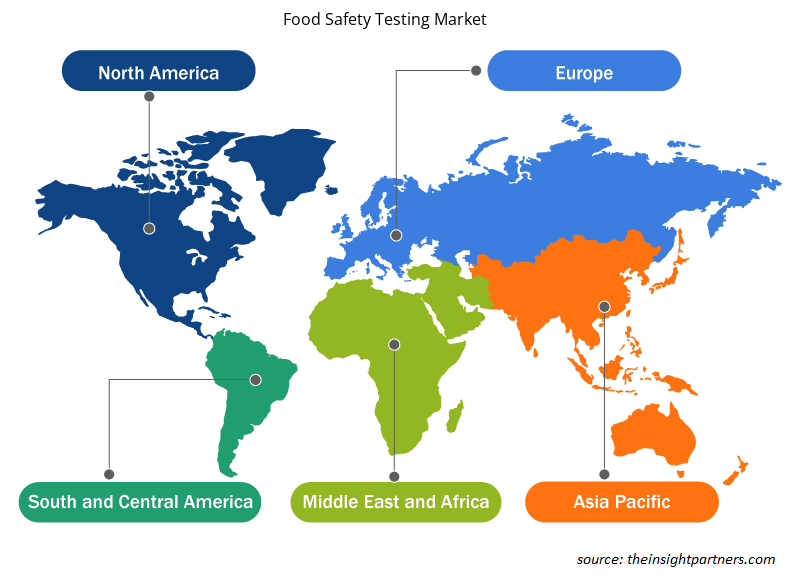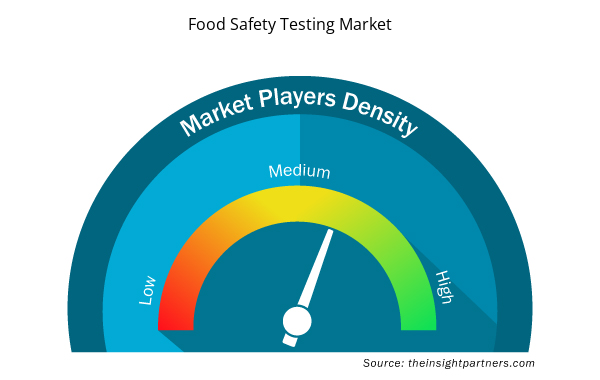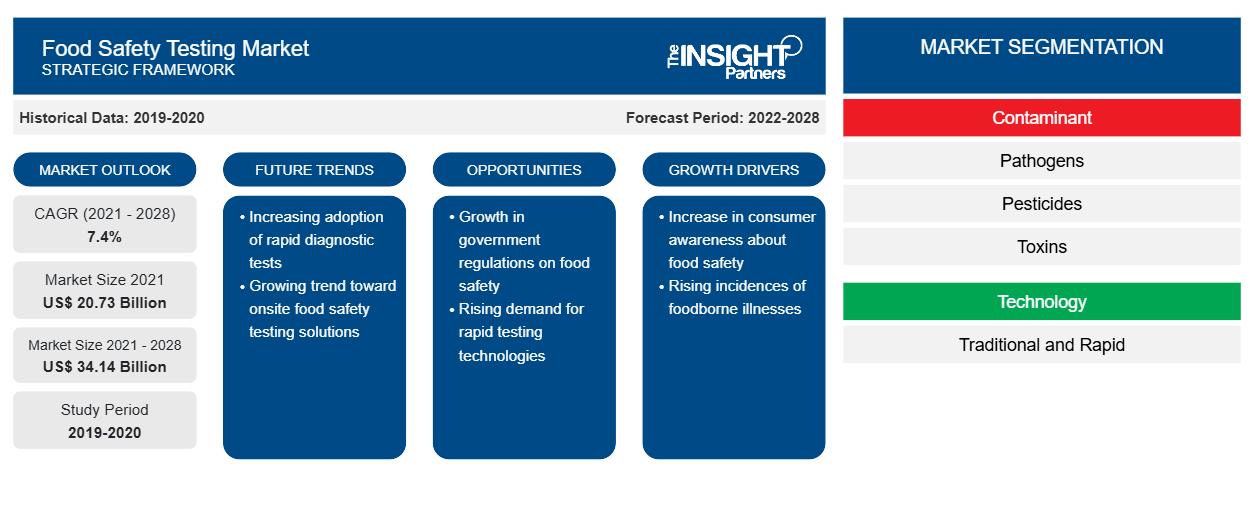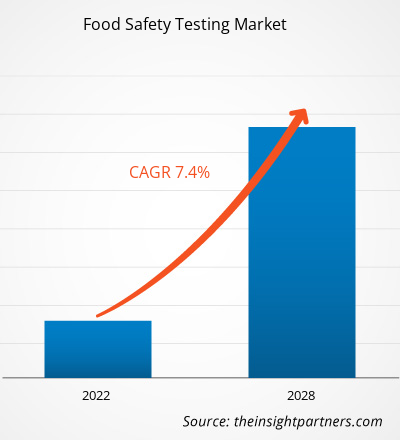식품 안전 테스트 시장 규모는 2021년에 207억 3,340만 달러로 평가되었으며, 2028년까지 341억 4,250만 달러에 도달할 것으로 예상됩니다. 2021년에서 2028년까지 연평균 성장률이 7.4%일 것으로 예상됩니다.
식품 안전 테스트는 물리화학적 특성, 구성 및 구조와 같은 다양한 특성에 대한 정보를 찾기 위해 식품과 그 내용물을 과학적으로 분석하는 것입니다. 이 정보는 소비를 위한 제품의 안전성을 결정하는 데 사용됩니다. 식품 매개 질병의 유병률이 증가함에 따라 건강 위험을 방지하기 위해 모든 식품 및 음료 제품에 대한 식품 안전 테스트가 필요하며, 이는 식품 안전 테스트 시장의 성장을 촉진합니다.
세계보건기구(WHO)가 발표한 데이터에 따르면 안전하지 않은 식품의 소비로 인해 매년 전 세계적으로 420,000명이 사망하고 6억 건의 식품 매개 질병이 발생합니다. 식품 매개 질병은 예방할 수 있으므로 수많은 조직과 정부가 여러 산업에 걸쳐 회복력 있고 견고한 식품 안전 시스템을 구축하기 위한 조정된 조치를 주도합니다. 게다가 2018년 세계은행 보고서에 따르면 식품 매개 질병으로 인해 생산성이 완전히 손실되어 발생하는 경제적 부담은 연간 952억 달러로 추산되었습니다. 따라서 식품 안전 테스트 시장은 식품 안전에 대한 소비자의 인식과 식품 매개 질병을 예방하기 위한 정부의 노력으로 인해 성장하고 있습니다.
귀하의 요구 사항에 맞게 이 보고서를 사용자 정의하세요
이 보고서의 일부 또는 국가 수준 분석, Excel 데이터 팩을 포함하여 모든 보고서에 대한 사용자 정의를 무료로 받을 수 있으며 신생 기업 및 대학을 위한 훌륭한 혜택과 할인 혜택을 이용할 수 있습니다.
- 이 보고서의 주요 시장 동향을 알아보세요.이 무료 샘플에는 시장 동향부터 추정 및 예측까지 다양한 데이터 분석이 포함됩니다.
COVID-19 팬데믹이 식품 안전 테스트 시장에 미치는 영향
소비자 인식은 전 세계 식품 안전 테스트 시장의 주요 원동력 중 하나입니다. COVID-19 발병은 소비자와 정부가 소비용 제품의 안전과 위생에 집중함에 따라 시장에 긍정적인 영향을 미쳤습니다. 모든 식품 및 음료 부문은 SARS-CoV-2가 매우 전염성이 강하고 식품 표면을 통해 이동할 수 있기 때문에 발병으로 인해 어려움에 직면해 있습니다. 육류 및 가금류 가공 시설은 전 세계 여러 시설의 근로자가 감염되면서 바이러스 전파와 관련하여 독특한 어려움에 직면했습니다. 예를 들어, 미국 보건복지부는 2020년 7월에 23개 주의 239개 시설이 COVID-19 감염에 시달렸다고 보고했습니다. 보고된 총 사례는 16,233건이었고 관련 사망자는 86명이었습니다. 게다가 2020년 11월에 중국은 중국에서 수입된 냉동 돼지 족집게 샘플이 해당 국가에서 새로운 COVID-19 사례를 유발했다고 보고했습니다. 식품 산업에서 발생한 이러한 COVID-19 감염 사례는 소비자와 정부 사이에 우려를 불러일으켰고, 이로 인해 건강 위험을 완화하기 위한 식품 안전 검사에 대한 수요가 증가했습니다.
시장 통찰력
식품 매개 질병 발생의 출현
식품 매개 질병은 독성이 있거나 전염성이 있습니다. 오염된 물이나 음식을 통해 신체에 들어온 화학 물질, 기생충, 바이러스로 인해 발생할 수 있습니다. 식품 매개 병원균은 뇌막염이나 심한 설사와 같은 쇠약해지는 감염을 일으킬 수 있습니다. 어떤 경우에는 화학적 오염이 암과 같은 장기 질환이나 급성 중독과 같은 단기 질환을 일으킬 수 있습니다. 안전하지 않은 음식의 몇 가지 예로는 해양 생물 독소가 포함된 날 조개류, 배설물로 오염된 야채와 과일, 조리되지 않은 동물성 식품이 있습니다. 대장균, 캄필로박터, 살모넬라는 매년 전 세계 수백만 명의 사람들에게 영향을 미치고 치명적이거나 심각한 결과를 초래하는 가장 흔한 식품 매개 병원균 중 하나입니다. 식품 매개 질병의 몇 가지 증상은 설사, 복통, 구토, 메스꺼움, 두통, 발열입니다. 게다가 리스테리아 감염은 신생아 사망이나 임산부 유산으로 이어집니다. 이 질병의 가능성은 비교적 낮지만 리스테리아의 치명률은 가장 심각한 식품 매개 감염 중 하나입니다. 비브리오 콜레라는 오염된 음식이나 물을 통해 사람을 감염시킵니다. 증상에는 심한 탈수, 심한 물 같은 설사, 구토, 복통이 포함될 수 있으며 사망에 이를 수도 있습니다. 다양한 종류의 해산물, 기장 죽, 야채, 쌀이 콜레라 발병에 연루되었습니다. 따라서 식품 매개 질병의 발생을 예방하기 위해 식품 안전 검사에 대한 수요가 증가하고 있습니다.
오염 물질에 대한 통찰력
오염 물질에 따라 식품 안전 테스트 시장은 병원균, 살충제, 독소, GMO 등으로 세분화됩니다. 병원균 세그먼트는 2020년에 가장 큰 시장 점유율을 차지했으며, GMO 세그먼트는 예측 기간 동안 시장에서 가장 높은 CAGR을 기록할 것으로 예상됩니다. 병원균 테스트는 식품 매개 질병의 발생을 없애거나 줄이기 위해 수행됩니다. 제거는 매우 필수적인 것으로 간주되어 식품 안전과 위생을 보장하기 위해 테스트 프로세스가 식품 생산 단계에서 구현됩니다. 식품 매개 질병을 일으킬 수 있는 가장 일반적인 병원균은 대장균, 리스테리아, 살모넬라균입니다. 병원균 테스트는 기존 기술이나 새로운 기술을 사용하여 수행할 수 있습니다. 기존 기술은 기존 세포 배양 표준을 사용하는 반면, 새로운 기술에는 레이저 기반 또는 분광 진단이 포함됩니다. 병원균은 식품 매개 질병의 가장 흔한 원인 중 하나이므로 병원균 세그먼트는 식품 안전 테스트 시장에서 가장 큰 시장 점유율을 차지합니다. 또한, 식품 및 음료 산업의 성장으로 인해 이 부문의 시장도 예측 기간 동안 성장할 것으로 예상됩니다.
기술 통찰력
기술에 따라 식품 안전 테스트 시장은 전통적 테스트와 빠른 테스트로 나뉩니다. 빠른 세그먼트는 2020년에 더 큰 시장 점유율을 차지했으며, 같은 세그먼트가 예측 기간 동안 시장에서 더 높은 CAGR을 기록할 것으로 예상됩니다. 주요 시장 참여자들은 서비스에 대한 수요가 높아 빠른 테스트에 혁신적인 제품을 도입하고 있습니다. 예를 들어, 2009년에 bioMérieux, Inc.는 식품 내 미생물 계수를 위한 자동화 시스템인 TEMPO를 출시했습니다. 자동화 시스템은 소형 카드를 사용하여 최확수(MPN) 방법에 관련된 지루한 수동 단계를 제거합니다. 따라서 자동화된 테스트는 간단한 추적성과 높은 처리량을 제공하며 수동 테스트에 대한 비용 효율적인 대안이기도 합니다. 게다가 이 회사는 식품 매개 병원균 검출에 사용되는 재조합 박테리오파지 기술도 도입하여 검출 가능한 수준에서 박테리아를 성장시키는 시간을 줄였습니다. 이러한 빠른 테스트는 재고 배치의 대기 기간이 크게 단축되므로 식품 제조업체의 비용 절감 측면에서 유용한 것으로 입증되었습니다. 따라서 신속한 테스트의 여러 이점은 예측 기간 동안 이 부문의 시장 성장을 촉진할 것으로 예상됩니다.
음식 유형 통찰력
식품 유형에 따라 식품 안전 테스트 시장은 육류, 가금류 및 해산물 제품, 유제품, 곡물 및 곡물, 가공 식품, 과일 및 채소 등으로 세분화됩니다. 육류, 가금류 및 해산물 제품 부문은 2020년에 가장 큰 시장 점유율을 차지했으며 과일 및 채소 부문은 예측 기간 동안 시장에서 가장 높은 CAGR을 기록할 것으로 예상됩니다. 육류, 가금류 및 해산물 제품 테스트에는 오염 물질 테스트와 한 육류 유형에 다른 육류 유형이 섞이는 식품 변조 테스트가 포함됩니다. 제품은 재, 지방, 수분, 단백질/질소, 중금속, 살충제, 항생제 및 약물, 소금, 염화물, 질산염 및 아질산염에 대해 테스트할 수 있습니다. 육류 제품은 이러한 제품의 유통 기한과 특성을 고려할 때 오염되거나 결함이 생길 가능성이 가장 높습니다. 따라서 이러한 제품에 대한 테스트는 모든 국가에서 필수입니다. 이 부문의 시장은 전 세계적으로 육류, 가금류 및 해산물 제품의 소비가 증가함에 따라 성장할 것으로 예상됩니다.
식품 안전 테스트 시장에서 활동하는 몇몇 업체는 SGS SA, Eurofins Scientific, Intertek Group Plc, TÜV SÜD, AES Laboratories Pvt. Ltd., TÜV NORD GROUP., Bureau Veritas, ALS Limited, NEOGEN Corporation, AsureQuality입니다. 이러한 회사는 시장에 광범위한 제품 포트폴리오를 제공합니다. 이 회사는 개발 도상국에 입지를 굳혔으며, 이는 식품 안전 테스트 시장 성장에 수익성 있는 기회를 제공합니다. 시장 참여자는 고객의 요구 사항을 충족하기 위해 고품질의 혁신적인 제품을 개발하고 있습니다.
스포트라이트 보고서
- 식품 안전 테스트 시장의 진보적인 산업 동향은 플레이어가 효과적인 장기 전략을 개발하는 데 도움이 됩니다.
- 선진국과 개발도상국 시장에서 채택한 사업 성장 전략
- 2019년부터 2028년까지 식품 안전 테스트 시장에 대한 정량적 분석
- 식품 안전 테스트에 대한 세계 수요 추산
- 산업에서 운영되는 구매자와 공급자의 효율성을 설명하기 위한 포터의 5가지 힘 분석
- 경쟁 시장 시나리오를 이해하기 위한 최근 개발
- 식품 안전 테스트 시장 성장을 촉진하고 제한하는 요인과 더불어 시장 동향 및 전망
- 상업적 이익을 뒷받침하는 시장 전략을 강조하여 의사 결정 과정을 지원하고 시장 성장을 이끕니다.
- 다양한 노드에서의 식품 안전 테스트 시장 규모
- 시장의 자세한 개요 및 세분화, 그리고 식품 안전 테스트 산업 역학
- 유망한 성장 기회가 있는 다양한 지역의 식품 안전 테스트 시장 규모
식품 안전 테스트 시장 지역 통찰력
Insight Partners의 분석가들은 예측 기간 동안 식품 안전 테스트 시장에 영향을 미치는 지역적 추세와 요인을 철저히 설명했습니다. 이 섹션에서는 북미, 유럽, 아시아 태평양, 중동 및 아프리카, 남미 및 중미의 식품 안전 테스트 시장 세그먼트와 지리에 대해서도 설명합니다.

- 식품 안전 테스트 시장을 위한 지역별 특정 데이터 얻기
식품 안전 테스트 시장 보고서 범위
| 보고서 속성 | 세부 |
|---|---|
| 2021년 시장 규모 | 207억 3천만 달러 |
| 2028년까지 시장 규모 | 341억 4천만 달러 |
| 글로벌 CAGR (2021-2028) | 7.4% |
| 역사적 데이터 | 2019-2020 |
| 예측 기간 | 2022-2028 |
| 다루는 세그먼트 | 오염 물질에 의해
|
| 포함된 지역 및 국가 | 북아메리카
|
| 시장 선도 기업 및 주요 회사 프로필 |
|
식품 안전 테스트 시장 참여자 밀도: 비즈니스 역학에 미치는 영향 이해
식품 안전 테스트 시장 시장은 소비자 선호도의 변화, 기술 발전, 제품의 이점에 대한 인식 증가와 같은 요인으로 인해 최종 사용자 수요가 증가함에 따라 빠르게 성장하고 있습니다. 수요가 증가함에 따라 기업은 제품을 확장하고, 소비자의 요구를 충족하기 위해 혁신하고, 새로운 트렌드를 활용하여 시장 성장을 더욱 촉진하고 있습니다.
시장 참여자 밀도는 특정 시장이나 산업 내에서 운영되는 회사나 기업의 분포를 말합니다. 주어진 시장 공간에 얼마나 많은 경쟁자(시장 참여자)가 존재하는지 그 규모나 총 시장 가치에 비해 나타냅니다.
식품 안전 테스트 시장에서 운영되는 주요 회사는 다음과 같습니다.
- 에스에스에스에스(주)
- 유로핀스 사이언티픽
- 인터텍 그룹 PLC
- 티유브이슈드
- AES 연구소 유한회사
면책 조항 : 위에 나열된 회사는 어떤 특별한 순서에 따라 순위가 매겨지지 않았습니다.

- 식품 안전 테스트 시장 주요 업체 개요를 알아보세요
식품 안전 테스트 시장 – 오염 물질별
- 병원균
- 살모넬라균
- 대장균
- 리스테리아
- 기타
- 살충제
- 독소
- GMOs
- 기타
식품 안전 테스트 시장 – 기술별
- 전통적인
- 빠른
- PCR 기반 테스트
- 면역 검정 기반 테스트
- 기타
식품 안전 테스트 시장 – 식품 유형별
- 육류, 가금류 및 해산물 제품
- 유제품
- 시리얼과 곡물
- 가공식품
- 과일과 채소
- 기타
회사 프로필
- 에스에스에스에스(주)
- 유로핀스 사이언티픽
- 인터텍 그룹 주식회사
- 티유브이슈드
- AES 연구소 유한회사
- TÜV NORD 그룹.
- 뷰로베리타스
- ALS 리미티드
- 네오젠 주식회사
- 아슈어퀄리티
- 역사적 분석(2년), 기준 연도, CAGR을 포함한 예측(7년)
- PEST 및 SWOT 분석
- 시장 규모 가치/양 - 글로벌, 지역, 국가
- 산업 및 경쟁 환경
- Excel 데이터 세트



Report Coverage
Revenue forecast, Company Analysis, Industry landscape, Growth factors, and Trends

Segment Covered
This text is related
to segments covered.

Regional Scope
North America, Europe, Asia Pacific, Middle East & Africa, South & Central America

Country Scope
This text is related
to country scope.
자주 묻는 질문
Based on technology, the food safety testing market is bifurcated into traditional and rapid. The rapid segment accounted for a larger market share in 2020. Rapid tests prove to be useful in terms of cost saving for food manufacturers as the waiting period for batches in inventory is significantly reduced. Thus, the multiple benefits of rapid testing is expected to fuel the market growth for this segment during the forecast period.
In 2020, China held the largest market share in the global food safety testing market. China is the most populated country in the world and is a major hub for food and beverages industry. The country annually imports and exports large quantities of food products to different parts of the world. As per data published by the International Trade Administration, U.S. Department of Commerce, the food and beverage sector of China reached US$ 595 billion in 2019 in terms of consumption. Moreover, considering the aggressive development of China and rising middle class population with high disposable income, numerous food brands are attempting to enter the market in the country. Therefore, the food trade as well as consumption in the country is growing at a high pace resulting in positive impact for food safety testing, as testing in the country is becoming increasingly stringent for food processing.
The pathogens segment accounted for the largest market share in 2020. Since pathogens are one of the most common reasons for foodborne illnesses, the pathogen segment holds the largest market share in the food safety testing market. Also, the market for this segment is expected to grow at a high pace during the forecast period due to the growth of the food & beverages industry.
The major players operating in the global food safety testing market are SGS SA, Eurofins Scientific, Intertek Group Plc, TÃœV SÃœD, AES Laboratories Pvt. Ltd., TÃœV NORD GROUP., Bureau Veritas, ALS Limited, NEOGEN Corporation, and AsureQuality.
Foodborne illnesses are toxic or infectious. They can be caused by the chemical substances, parasites, viruses entering the body through contaminated water or food. In some cases chemical contamination can cause long-term diseases, such as cancer, or short-term illness, such as acute poisoning. A few examples of unsafe food are raw shellfish containing marine biotoxins, vegetables and fruits contaminated with feces, and uncooked foods of animal origin. E. Coli, campylobacter, and salmonella are among the most common foodborne pathogens that affect millions of people worldwide annually and result in fatal or severe outcomes. Moreover, listeria infection leads to death of newborn babies or miscarriages in pregnant women. Although the chances of this disease are relatively low, the fatality of listeria makes it one of the most serious foodborne infections. Vibrio cholera infects people through contaminated food or water. Various types of seafood, millet gruel, vegetables, and rice have been implicated in cholera outbreaks. Therefore, the demand for food safety testing is increasing to prevent the incidence of foodborne illnesses.
In 2020, North America held the largest share of the market. The Centre for Disease Control and Prevention (CDC) has determined that one out of ten people fall sick due to foodborne illness each year in the US. The rising incidence of foodborne diseases has propelled the need for rapid testing, which is driving the market growth in North America. Additionally, enhanced detection and surveillance methods have fueled the food safety testing market growth in North America.
Trends and growth analysis reports related to Consumer Goods : READ MORE..
The List of Companies - Food Safety Testing Market
- SGS SA
- Eurofins Scientific
- INTERTEK GROUP PLC
- TÜV SÜD
- AES Laboratories Pvt. Ltd.
- TÜV NORD GROUP.
- BUREAU VERITAS
- ALS Limited
- NEOGEN Corporation
- AsureQuality
The Insight Partners performs research in 4 major stages: Data Collection & Secondary Research, Primary Research, Data Analysis and Data Triangulation & Final Review.
- Data Collection and Secondary Research:
As a market research and consulting firm operating from a decade, we have published and advised several client across the globe. First step for any study will start with an assessment of currently available data and insights from existing reports. Further, historical and current market information is collected from Investor Presentations, Annual Reports, SEC Filings, etc., and other information related to company’s performance and market positioning are gathered from Paid Databases (Factiva, Hoovers, and Reuters) and various other publications available in public domain.
Several associations trade associates, technical forums, institutes, societies and organization are accessed to gain technical as well as market related insights through their publications such as research papers, blogs and press releases related to the studies are referred to get cues about the market. Further, white papers, journals, magazines, and other news articles published in last 3 years are scrutinized and analyzed to understand the current market trends.
- Primary Research:
The primarily interview analysis comprise of data obtained from industry participants interview and answers to survey questions gathered by in-house primary team.
For primary research, interviews are conducted with industry experts/CEOs/Marketing Managers/VPs/Subject Matter Experts from both demand and supply side to get a 360-degree view of the market. The primary team conducts several interviews based on the complexity of the markets to understand the various market trends and dynamics which makes research more credible and precise.
A typical research interview fulfils the following functions:
- Provides first-hand information on the market size, market trends, growth trends, competitive landscape, and outlook
- Validates and strengthens in-house secondary research findings
- Develops the analysis team’s expertise and market understanding
Primary research involves email interactions and telephone interviews for each market, category, segment, and sub-segment across geographies. The participants who typically take part in such a process include, but are not limited to:
- Industry participants: VPs, business development managers, market intelligence managers and national sales managers
- Outside experts: Valuation experts, research analysts and key opinion leaders specializing in the electronics and semiconductor industry.
Below is the breakup of our primary respondents by company, designation, and region:

Once we receive the confirmation from primary research sources or primary respondents, we finalize the base year market estimation and forecast the data as per the macroeconomic and microeconomic factors assessed during data collection.
- Data Analysis:
Once data is validated through both secondary as well as primary respondents, we finalize the market estimations by hypothesis formulation and factor analysis at regional and country level.
- Macro-Economic Factor Analysis:
We analyse macroeconomic indicators such the gross domestic product (GDP), increase in the demand for goods and services across industries, technological advancement, regional economic growth, governmental policies, the influence of COVID-19, PEST analysis, and other aspects. This analysis aids in setting benchmarks for various nations/regions and approximating market splits. Additionally, the general trend of the aforementioned components aid in determining the market's development possibilities.
- Country Level Data:
Various factors that are especially aligned to the country are taken into account to determine the market size for a certain area and country, including the presence of vendors, such as headquarters and offices, the country's GDP, demand patterns, and industry growth. To comprehend the market dynamics for the nation, a number of growth variables, inhibitors, application areas, and current market trends are researched. The aforementioned elements aid in determining the country's overall market's growth potential.
- Company Profile:
The “Table of Contents” is formulated by listing and analyzing more than 25 - 30 companies operating in the market ecosystem across geographies. However, we profile only 10 companies as a standard practice in our syndicate reports. These 10 companies comprise leading, emerging, and regional players. Nonetheless, our analysis is not restricted to the 10 listed companies, we also analyze other companies present in the market to develop a holistic view and understand the prevailing trends. The “Company Profiles” section in the report covers key facts, business description, products & services, financial information, SWOT analysis, and key developments. The financial information presented is extracted from the annual reports and official documents of the publicly listed companies. Upon collecting the information for the sections of respective companies, we verify them via various primary sources and then compile the data in respective company profiles. The company level information helps us in deriving the base number as well as in forecasting the market size.
- Developing Base Number:
Aggregation of sales statistics (2020-2022) and macro-economic factor, and other secondary and primary research insights are utilized to arrive at base number and related market shares for 2022. The data gaps are identified in this step and relevant market data is analyzed, collected from paid primary interviews or databases. On finalizing the base year market size, forecasts are developed on the basis of macro-economic, industry and market growth factors and company level analysis.
- Data Triangulation and Final Review:
The market findings and base year market size calculations are validated from supply as well as demand side. Demand side validations are based on macro-economic factor analysis and benchmarks for respective regions and countries. In case of supply side validations, revenues of major companies are estimated (in case not available) based on industry benchmark, approximate number of employees, product portfolio, and primary interviews revenues are gathered. Further revenue from target product/service segment is assessed to avoid overshooting of market statistics. In case of heavy deviations between supply and demand side values, all thes steps are repeated to achieve synchronization.
We follow an iterative model, wherein we share our research findings with Subject Matter Experts (SME’s) and Key Opinion Leaders (KOLs) until consensus view of the market is not formulated – this model negates any drastic deviation in the opinions of experts. Only validated and universally acceptable research findings are quoted in our reports.
We have important check points that we use to validate our research findings – which we call – data triangulation, where we validate the information, we generate from secondary sources with primary interviews and then we re-validate with our internal data bases and Subject matter experts. This comprehensive model enables us to deliver high quality, reliable data in shortest possible time.


 이 보고서에 대한 무료 샘플을 받으세요
이 보고서에 대한 무료 샘플을 받으세요